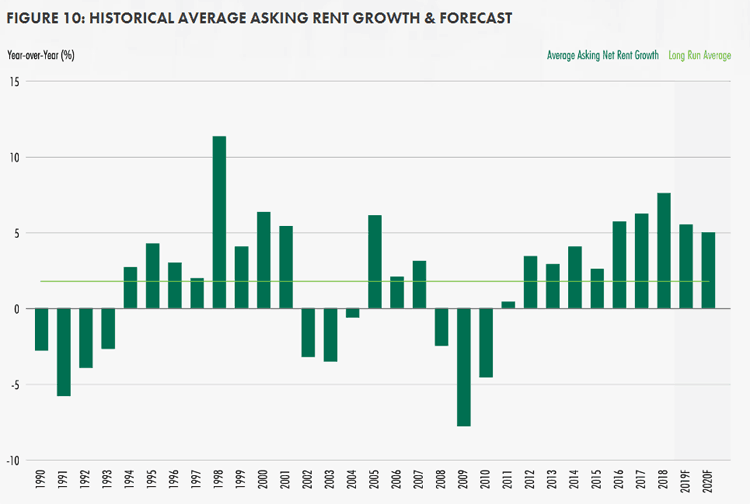2020 will be again be a solid year for industrial real estate, mostly meaning warehouse space, but the edge real estate developer have enjoyed for several years now will soften a bit.
So say leading real estate firms CBRE and Cushman & Wakefield in separate outlook reports for the year ahead.
Supply Chain Digest Says...
|
 |
Cushman & Wakefield says that builders actually added more space in North America in 2019 than shippers leased, the first time that has happened since 2009. |
 |
What do you say? |
| Click here to send us your comments |
 |
| Click here to see reader feedback |
|
CBRE, for example, says that absorption of warehouse space is going to slow in 2020 – but mostly because there is little space left to lease in many markets.
Interestingly, CBRE notes that "Anecdotally, we are seeing higher-than-normal renewal rates, particularly in the markets with the lowest vacancy rates, and this trend should continue if not accelerate in the near term."
Overall, CBRE believes the market for warehouse space will remain stable even as ecommerce growth continues to transform logistics. As operations become more complex for occupiers, this will push many shippers towards outsourcing, paving the way for growth in third-party logistics providers.
However, CBRE says given that there will be more renewal activity and fewer leases for new space. It also says supply for warehouse space will outpace demand by 20 million to 30 million sq. ft. this year.
If accurate, it will be the first time there will be an overhang of space since the 2008 recession, albeit representing only 0.2% of total industrial inventory.
But while the overall vacancy rate may increase slightly, it should remain near historic lows again this year.
And rates for warehouse space on average will remain strong. CBRE forecasts rates will rise 5% this year, down just a bit from the increase in 2018. If correct, that would make it five consecutive years of lease rate hikes of 5% or more, as shown in the graphic below.

Source: CBRE
Of course, national averages mask dramatically different trends in individual metro markets.
However, CBRE says that demand for smaller warehouses of less than 120,000 sq. ft. will accelerate as ecommerce companies race to offer same-day delivery to customers. These properties have seen rents rise by 30% in the past five years, double the growth of big-box rents at 15%.
(See More Below)
|
CATEGORY SPONSOR: SOFTEON |
|
|
| |
|
|
Cushman & Wakefield sees similar but slightly different trends. Its latest research finds that construction of new distribution space North America is expected to exceed demand in 2020 and 2021, meaning shippers may be soon to gain some leverage for the first time in years.
Warehouse developers are forecast to deliver about 301 million square feet of new warehouse space this year, while shippers will lease about 242 million square feet.
The tight market in many areas has driven vacancy rates to near record lows, naturally sending rates higher. However, Cushman & Wakefield says last year that the industrial real-estate market moved to a better balance between supply and demand.
In fact, Cushman & Wakefield says that builders actually added more space in North America in 2019 than shippers leased, the first time that has happened since 2009.
However, warehouse space remains tight by historical standards. Cushman & Wakefield expects vacancy rates to rise to 5.2% by the end of 2021, up a bit from 4.6% at the end of 2019, versus an average vacancy rate of 6.2% from 2011 to 2021.
Cushman & Wakefield also expects warehouse rents to rise to $6.95 per square foot by the end of 2021, up from $6.51 a square foot as of the end of 2019. Again, rates differ dramatically depending on metro market.
“Higher replacement costs, land scarcity and elongated permitting remain governors to supply,” Thomas Olinger, CFO at giant real estate developer Prologis, on a recent call with analysts, the Wall Street Journal’s Micah Maidenberg reports.
Prologis expects its portfolio of properties across the U.S., Europe and other regions will end 2020 96% to 97% occupied. The company said it is looking to boost rents as leases expire.
Any thoughts on trends and rates in DC space? Let us know your thoughts at the Feedback section below.
|